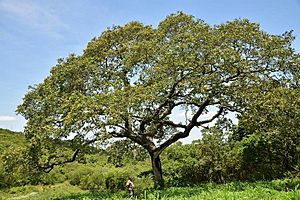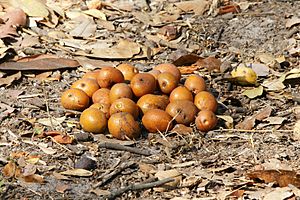Mobola plum facts for kids
Quick facts for kids Mobola plum |
|
|---|---|
 |
|
 |
|
| Scientific classification | |
| Genus: |
Parinari
|
| Species: |
curatellifolia
|
The Mobola plum (scientific name: Parinari curatellifolia) is a special evergreen tree that grows in many parts of Africa. People in different areas call it by various names, like Tutu in Bambara or Ìdòfún in Yoruba. In South Africa, it's known as mmupudu or mupundu. This tree is famous for its delicious fruit, which is why people often leave it standing when they clear land for farming.
You can find the Mobola plum tree across a huge area of Africa. It grows in the Guinea Savanna region of West Africa, from Senegal all the way to Chad. It also thrives in seasonal woodlands across the equator, through Kenya and the eastern side of the continent. You'll see it in the Miombo woodlands inland, reaching Zambia and Zimbabwe. Its southernmost home is just outside the tropics in South Africa.
What the Mobola Plum Tree Looks Like
This tree can look quite different depending on where it grows. In places with lots of rain (about 1,000 millimeters or more each year), it can grow very big. It might reach 20 to 22 meters tall, with its branches spreading out about 20 meters wide. Its branches can hang down or grow straight up, giving the tree an impressive shape.
If there's less rain, the tree usually looks like a mushroom and only grows up to 15 meters tall. Sometimes, in south-central Africa, it's the main tree in woodlands where the soil stays very wet for several months a year.
The Mobola plum tree has rough, cork-like bark. Its leaves are stiff and feel like leather, with soft grey hairs on their underside. The fruits are plum-like and turn a yellow-brown color when they are ripe and ready to eat.
How People Use the Mobola Plum
The Mobola plum is a traditional food in Africa. This fruit, though not widely known, could help improve nutrition and food security in many places. It also supports local farming and helps keep the land healthy.
The wood of the Mobola plum tree is very hard and heavy. This is because it contains tiny silica crystals. This makes the wood difficult to work with. Sadly, it doesn't last very long, so it's not used much for building. However, it does make good charcoal.
The most important part of the tree is its tasty fruit. The fruits appear early in the dry season and can be picked for three months or even longer. People enjoy them as a snack. The seed inside the fruit has a lot of oil. The crushed fruit pulp is also used to make drinks. Since it ferments well, it's often used to make alcoholic beverages too.
The tree is also used in some traditional practices in Zimbabwe.
See also
- Parinari curatellifolia in Spanish for kids: Parinari curatellifolia para niños

